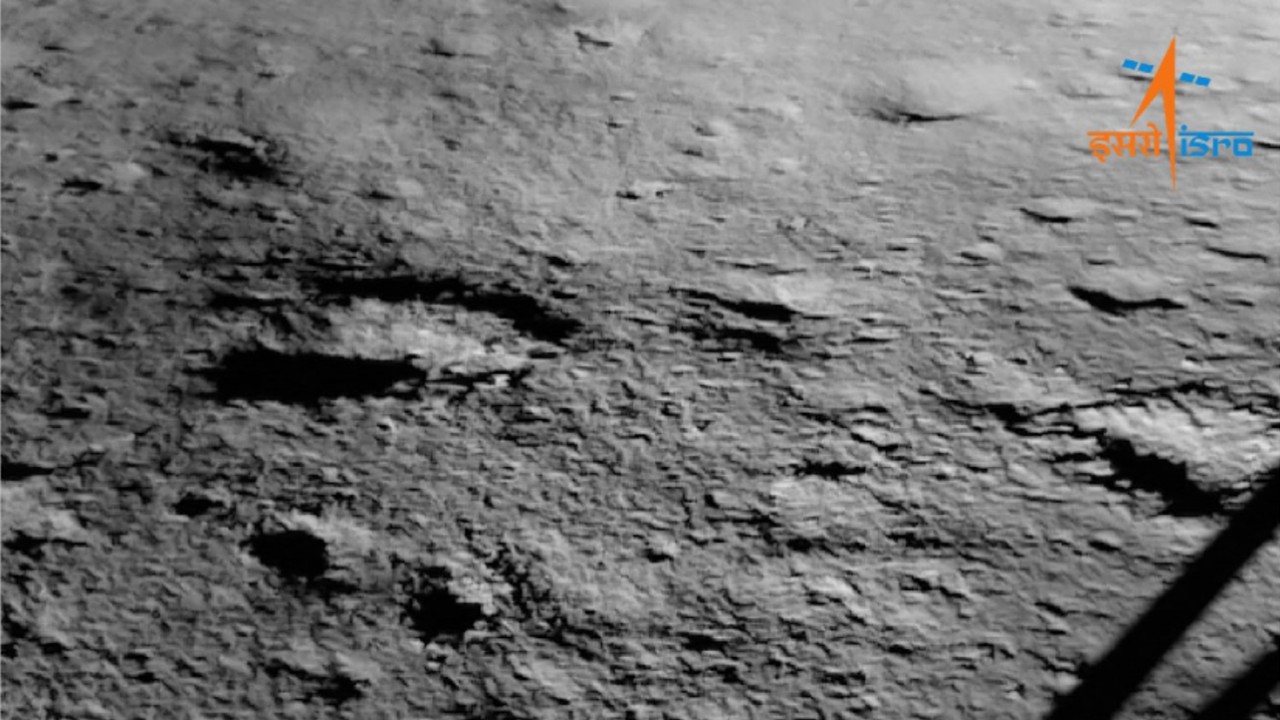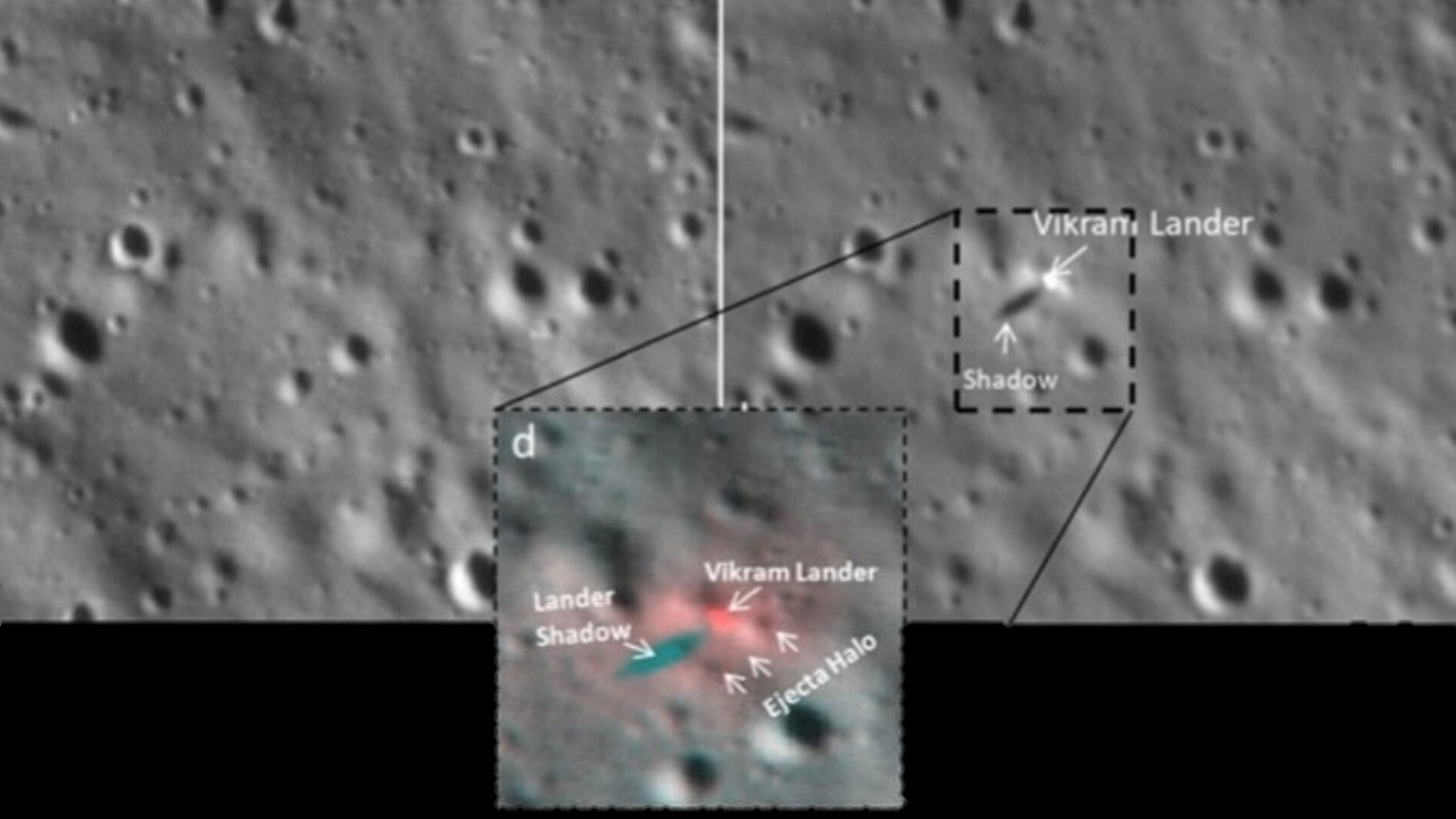
On Aug. 23, 2023, India did what only three other countries before it had done: Make a successful soft landing on the moon.
Millions of eyes watched the Indian Space Research Organisation (ISRO)'s Chandrayaan-3 as its lander touched down on the lunar surface and began its science operations in the days afterward. In fact, some of those eyes were aboard the mission's predecessor, Chandrayaan-2, whose cameras captured the landing site of Chandrayaan-3's Vikram lander from its perch in lunar orbit.
It seems that those photos from Chandrayaan-2's orbiter captured an "ejecta halo," a huge ring-shaped plume of moon dust that the latter-day lander's thrusters left in the lunar soil as they glided it to a touchdown.
Chandrayaan-2's photos show the volume of that initial success: As Chandryaan-3's lander touched down, its engines scattered the lunar regolith, or moon dust, below. In a new study, scientists estimate the landing displaced around 2.06 metric tons (4,500 pounds) of lunar regolith, sending it across an area of 1,167 square feet (108.4 square meters).
Related: India's Chandrayaan-3 moon rover reveals surprising sulfur find in lunar south pole soil
Scientists noticed the halo based on the differences in reflectivity in the newly-disturbed top layers of moon dust, or epiregolith. "The loss of cohesion of the epiregolith and consequent exposure of subsurface regolith may have resulted in increased photometric scattering and thus, the reflectance anomaly around the lander," the authors of the new study on the ejecta halo write.

In a way, Chandrayaan-2 witnessed Chandrayaan-3 do what it could not.
Get the Space.com Newsletter
Breaking space news, the latest updates on rocket launches, skywatching events and more!
Chandrayaan-2 launched from southern India's Satish Dhawan Space Center on July 22, 2019 and entered lunar orbit on Aug. 19. The mission set out to put a lander and rover near the lunar south polar region, something that had never been done before.
Unfortunately, when the lander set off on Sept. 6 (Sept. 7 IST) 2019, ISRO ground control lost contact when it was just 1.3 miles (2.1 kilometers) above the lunar surface, and never re-established it.
Nevertheless, Chandrayaan-2’s orbiter continued to function normally, mapping the lunar terrain and taking high-resolution photographs of the lunar surface.
Nearly four years later, Chandrayaan-3 lifted off from the same launch site with the same general mission: Place a lander and rover in the south polar region. On Aug. 23, 2023, ISRO conducted the first successful landing near the lunar south pole.
Only three nations had soft-landed on the moon previously: The United States, the Soviet Union, and China. But more soft landings should be coming shortly; NASA has funded several robotic missions in support of its moon-faring Artemis program, some of which may touch down as soon as 2024. Japanese company ispace has already attempted to land a robot on the moon, and Russia assures the world it will soon be back after the failed landing attempt of its Luna-25 mission, which crashed in August 2023.
A study of Chandrayaan-3's ejecta halo was published in the Journal of the Indian Society of Remote Sensing on Oct. 26.
Join our Space Forums to keep talking space on the latest missions, night sky and more! And if you have a news tip, correction or comment, let us know at: community@space.com.

Rahul Rao is a graduate of New York University's SHERP and a freelance science writer, regularly covering physics, space, and infrastructure. His work has appeared in Gizmodo, Popular Science, Inverse, IEEE Spectrum, and Continuum. He enjoys riding trains for fun, and he has seen every surviving episode of Doctor Who. He holds a masters degree in science writing from New York University's Science, Health and Environmental Reporting Program (SHERP) and earned a bachelors degree from Vanderbilt University, where he studied English and physics.









